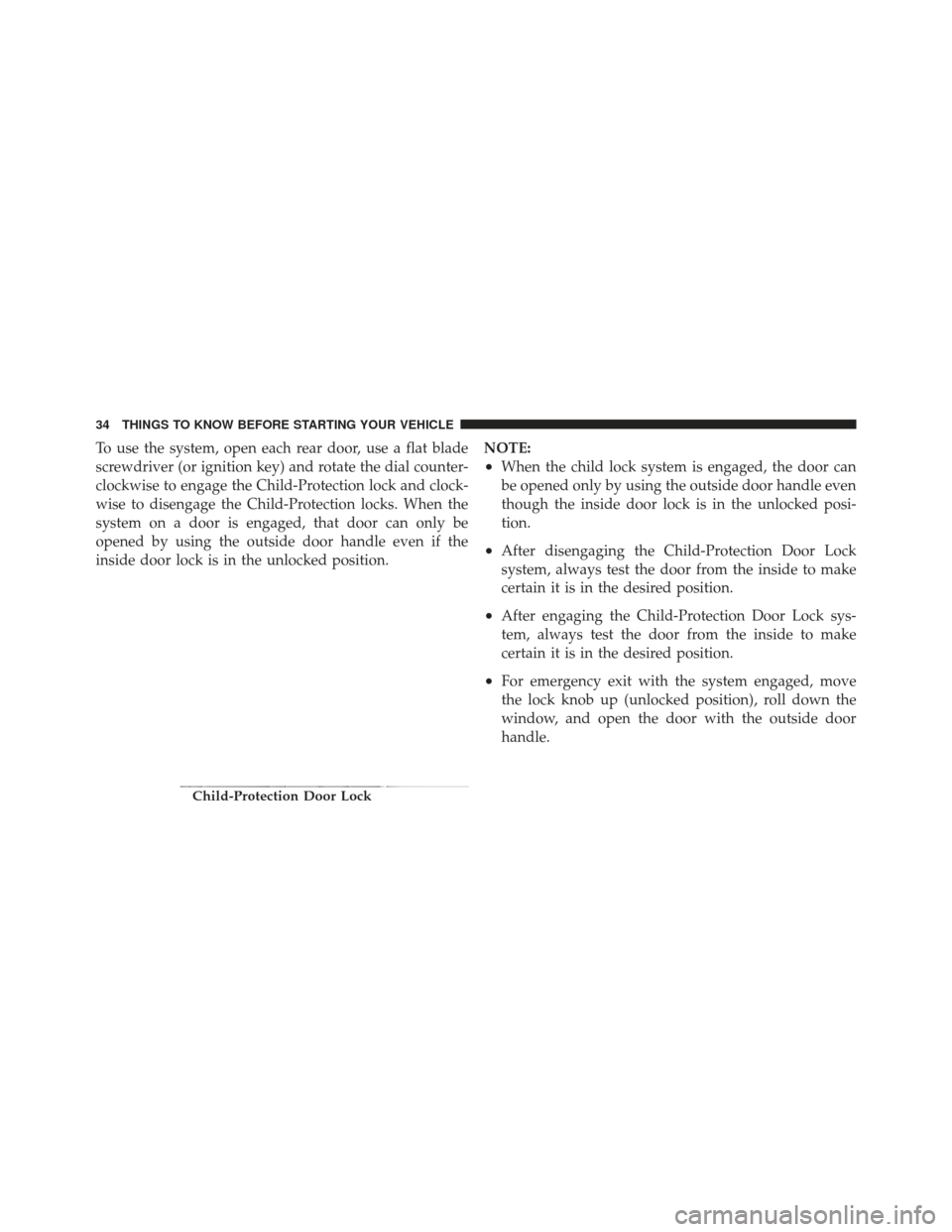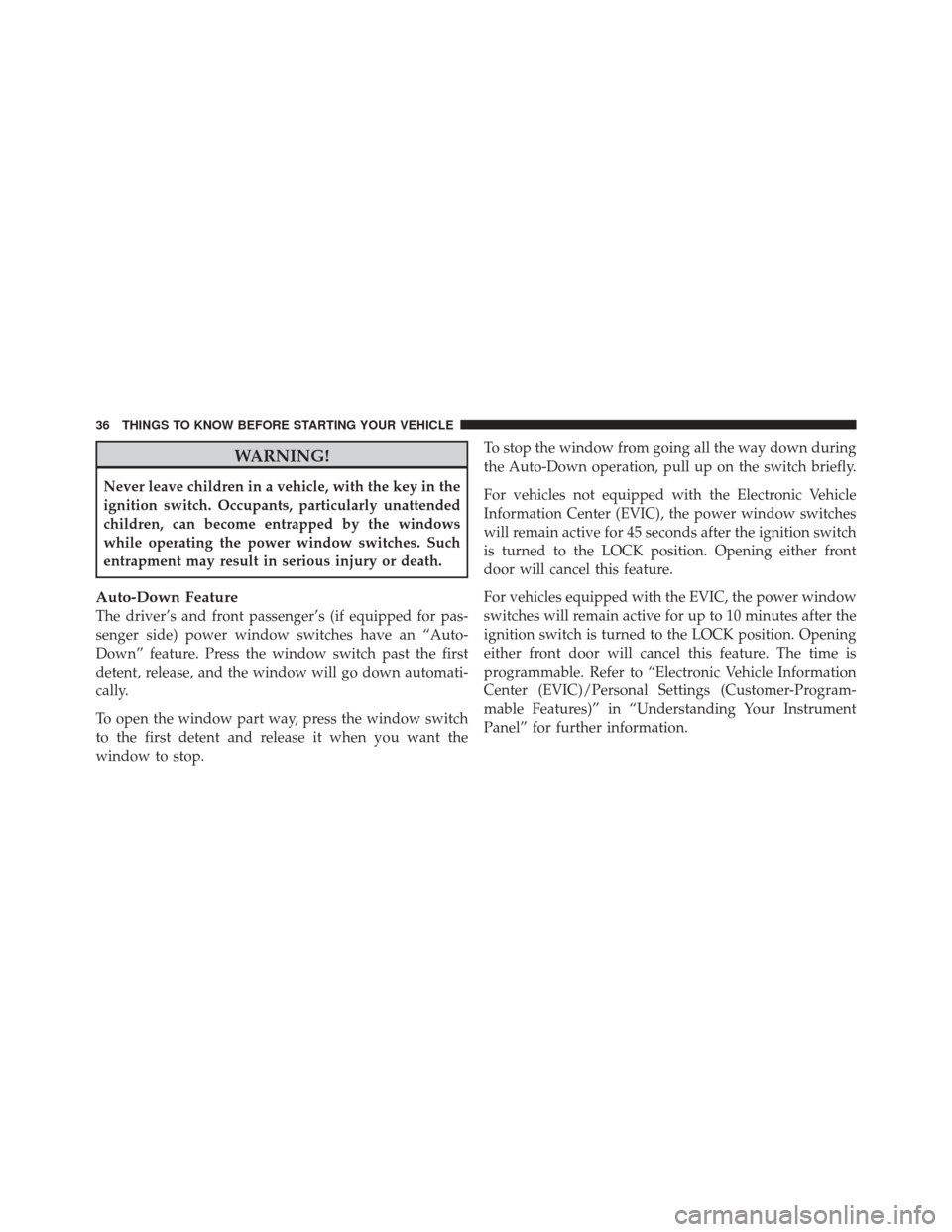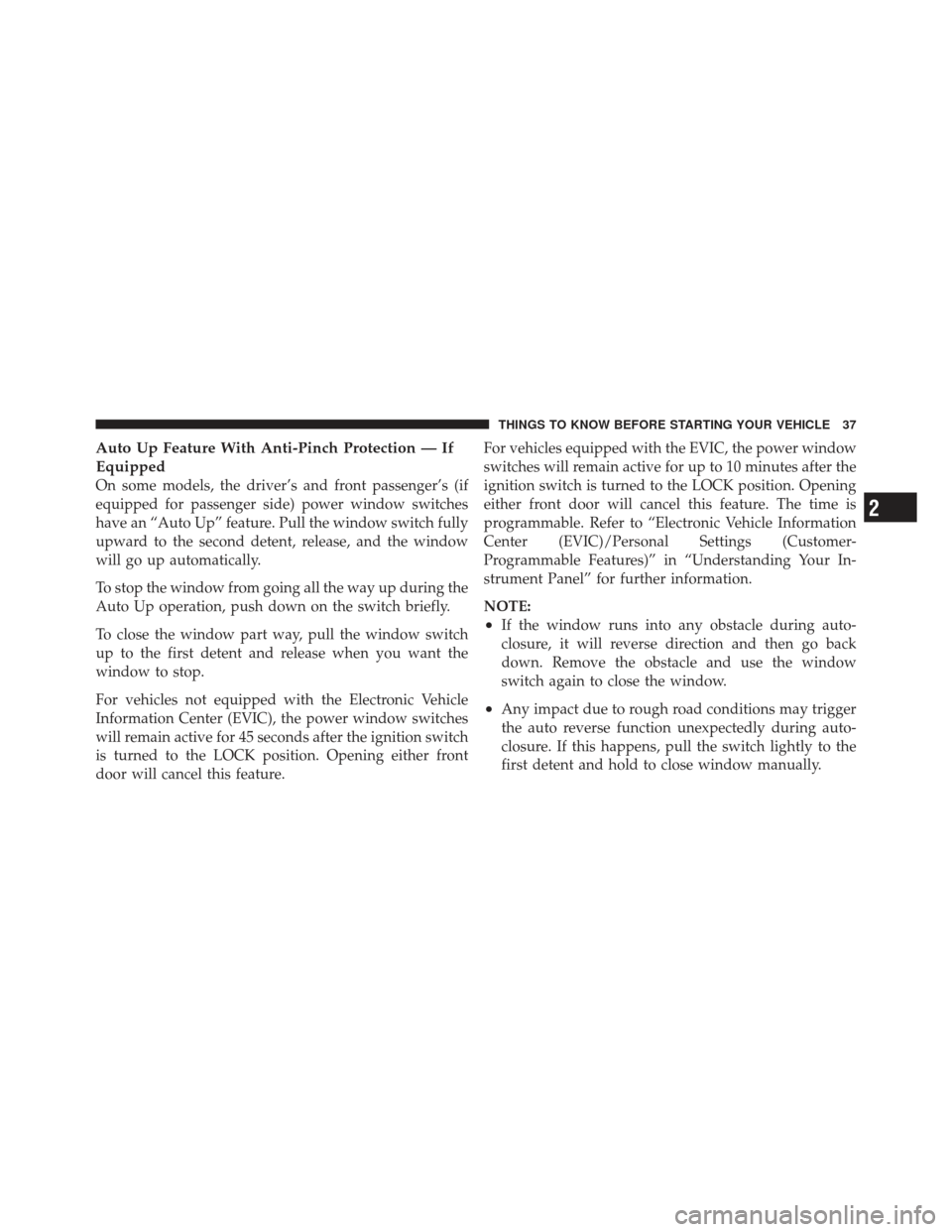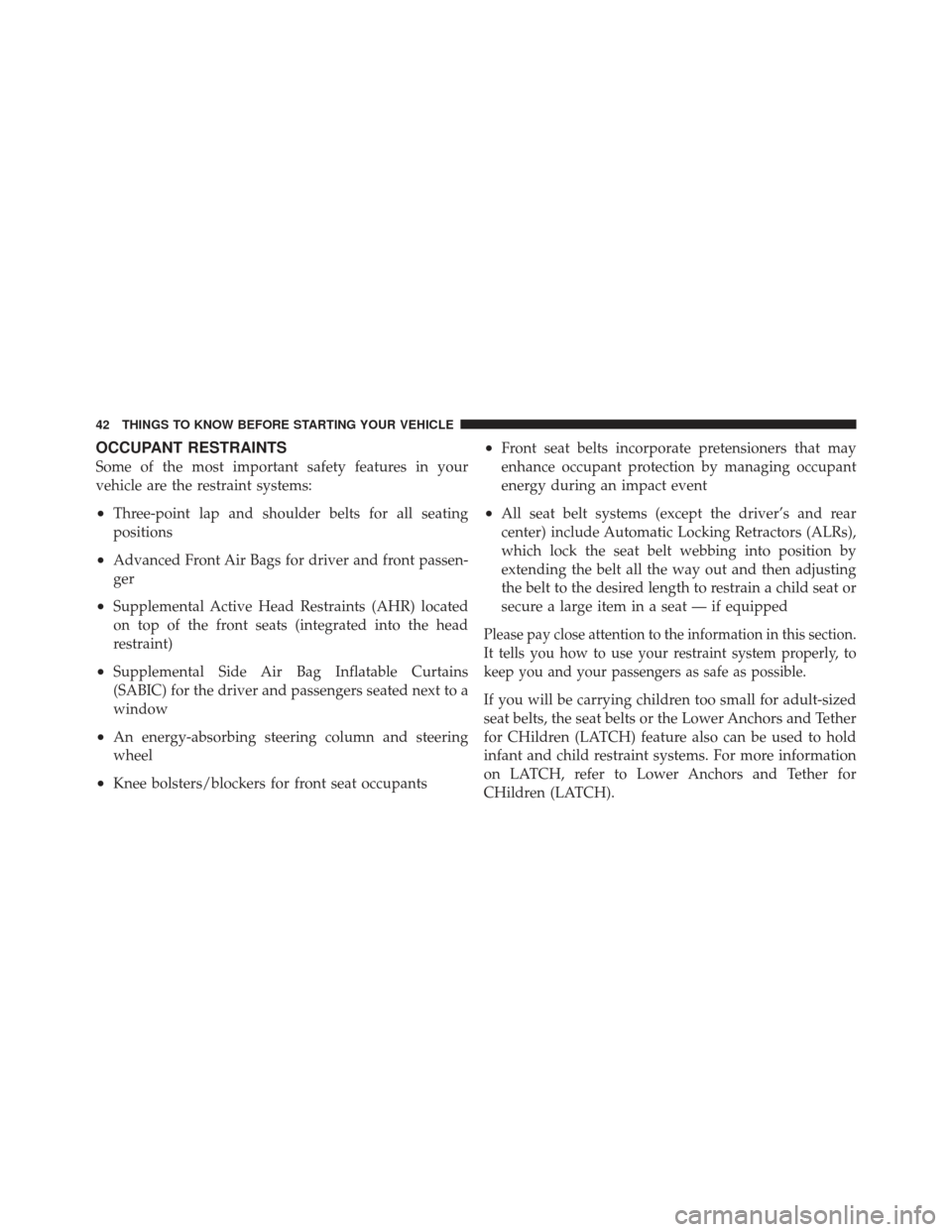Page 36 of 558

To use the system, open each rear door, use a flat blade
screwdriver (or ignition key) and rotate the dial counter-
clockwise to engage the Child-Protection lock and clock-
wise to disengage the Child-Protection locks. When the
system on a door is engaged, that door can only be
opened by using the outside door handle even if the
inside door lock is in the unlocked position.NOTE:
•When the child lock system is engaged, the door can
be opened only by using the outside door handle even
though the inside door lock is in the unlocked posi-
tion.
•After disengaging the Child-Protection Door Lock
system, always test the door from the inside to make
certain it is in the desired position.
•After engaging the Child-Protection Door Lock sys-
tem, always test the door from the inside to make
certain it is in the desired position.
•For emergency exit with the system engaged, move
the lock knob up (unlocked position), roll down the
window, and open the door with the outside door
handle.
Child-Protection Door Lock
34 THINGS TO KNOW BEFORE STARTING YOUR VEHICLE
Page 37 of 558
WARNING!
Avoid trapping anyone in a vehicle in a collision.
Remember that the rear doors can only be opened
from the outside when the Child-Protection locks are
engaged.
WINDOWS
Power Windows
The window controls on the driver’s door trim panel
control all the door windows.There are single window controls on each passenger door
trim panel, which operate the passenger door windows.
The window controls will operate when the ignition
switch is in the ON/RUN or ACC position.
Power Window Switches
2
THINGS TO KNOW BEFORE STARTING YOUR VEHICLE 35
Page 38 of 558

WARNING!
Never leave children in a vehicle, with the key in the
ignition switch. Occupants, particularly unattended
children, can become entrapped by the windows
while operating the power window switches. Such
entrapment may result in serious injury or death.
Auto-Down Feature
The driver’s and front passenger’s (if equipped for pas-
senger side) power window switches have an “Auto-
Down” feature. Press the window switch past the first
detent, release, and the window will go down automati-
cally.
To open the window part way, press the window switch
to the first detent and release it when you want the
window to stop.To stop the window from going all the way down during
the Auto-Down operation, pull up on the switch briefly.
For vehicles not equipped with the Electronic Vehicle
Information Center (EVIC), the power window switches
will remain active for 45 seconds after the ignition switch
is turned to the LOCK position. Opening either front
door will cancel this feature.
For vehicles equipped with the EVIC, the power window
switches will remain active for up to 10 minutes after the
ignition switch is turned to the LOCK position. Opening
either front door will cancel this feature. The time is
programmable. Refer to “Electronic Vehicle Information
Center (EVIC)/Personal Settings (Customer-Program-
mable Features)” in “Understanding Your Instrument
Panel” for further information.
36 THINGS TO KNOW BEFORE STARTING YOUR VEHICLE
Page 39 of 558

Auto Up Feature With Anti-Pinch Protection — If
Equipped
On some models, the driver’s and front passenger’s (if
equipped for passenger side) power window switches
have an “Auto Up” feature. Pull the window switch fully
upward to the second detent, release, and the window
will go up automatically.
To stop the window from going all the way up during the
Auto Up operation, push down on the switch briefly.
To close the window part way, pull the window switch
up to the first detent and release when you want the
window to stop.
For vehicles not equipped with the Electronic Vehicle
Information Center (EVIC), the power window switches
will remain active for 45 seconds after the ignition switch
is turned to the LOCK position. Opening either front
door will cancel this feature.For vehicles equipped with the EVIC, the power window
switches will remain active for up to 10 minutes after the
ignition switch is turned to the LOCK position. Opening
either front door will cancel this feature. The time is
programmable. Refer to “Electronic Vehicle Information
Center (EVIC)/Personal Settings (Customer-
Programmable Features)” in “Understanding Your In-
strument Panel” for further information.
NOTE:
•If the window runs into any obstacle during auto-
closure, it will reverse direction and then go back
down. Remove the obstacle and use the window
switch again to close the window.
•Any impact due to rough road conditions may trigger
the auto reverse function unexpectedly during auto-
closure. If this happens, pull the switch lightly to the
first detent and hold to close window manually.
2
THINGS TO KNOW BEFORE STARTING YOUR VEHICLE 37
Page 40 of 558

WARNING!
There is no anti-pinch protection when the window
is almost closed. Be sure to clear all objects from the
window before closing.
Reset
It may be necessary at some point in time to reactivate the
Auto Up feature. To do so, perform the following proce-
dure:
1. Pull the window switch up to close the window
completely and continue to hold the switch up for an
additional two seconds after the window is closed.2. Push the window switch down firmly to the second
detent to open the window completely and continue to
hold the switch down for an additional two seconds after
the window is fully open.
Window Lockout Button
The window lockout button on the driver’s door trim
panel allows you to disable the window control on the
rear doors. To disable the window control on the other
doors, press and release the window LOCKOUT button
(setting it in the down position). To enable the window
controls, press and release the window LOCKOUT but-
ton again (setting it in the up position).
38 THINGS TO KNOW BEFORE STARTING YOUR VEHICLE
Page 41 of 558
Wind Buffeting
Wind buffeting can be described as the perception of
pressure on the ears or a helicopter-type sound in the
ears. Your vehicle may exhibit wind buffeting with the
windows down, or the sunroof or Sky Slider™ (if
equipped) in certain open or partially open positions.
This is a normal occurrence and can be minimized. If the
buffeting occurs with the rear windows open, then open
the front and rear windows together to minimize the
buffeting. If the buffeting occurs with the sunroof or Sky
Slider™ open, adjust the sunroof or Sky Slider™ opening
to minimize the buffeting or open any window.
Window Lockout Button
2
THINGS TO KNOW BEFORE STARTING YOUR VEHICLE 39
Page 42 of 558
LIFTGATE
To open the liftgate, pull up (squeeze) on the handle and
lift.NOTE:
Use the power door LOCK switch on either front
door trim panel or the Remote Keyless Entry (RKE)
transmitter to lock and unlock the liftgate. The manual
door locks on the doors and the driver’s door lock
cylinder will not lock and unlock the liftgate.
WARNING!
Driving with the liftgate open can allow poisonous
exhaust gases into your vehicle. You and your pas-
sengers could be injured by these fumes. Keep the
liftgate closed when you are operating the vehicle.
Liftgate Flipper Glass
The liftgate flipper glass is also unlocked when the
liftgate is unlocked. To open the flipper glass, push up on
the window switch located on the liftgate.
Liftgate Release
40 THINGS TO KNOW BEFORE STARTING YOUR VEHICLE
Page 44 of 558

OCCUPANT RESTRAINTS
Some of the most important safety features in your
vehicle are the restraint systems:
•Three-point lap and shoulder belts for all seating
positions
•Advanced Front Air Bags for driver and front passen-
ger
•Supplemental Active Head Restraints (AHR) located
on top of the front seats (integrated into the head
restraint)
•Supplemental Side Air Bag Inflatable Curtains
(SABIC) for the driver and passengers seated next to a
window
•An energy-absorbing steering column and steering
wheel
•Knee bolsters/blockers for front seat occupants
•Front seat belts incorporate pretensioners that may
enhance occupant protection by managing occupant
energy during an impact event
•All seat belt systems (except the driver’s and rear
center) include Automatic Locking Retractors (ALRs),
which lock the seat belt webbing into position by
extending the belt all the way out and then adjusting
the belt to the desired length to restrain a child seat or
secure a large item in a seat — if equipped
Please pay close attention to the information in this section.
It tells you how to use your restraint system properly, to
keep you and your passengers as safe as possible.
If you will be carrying children too small for adult-sized
seat belts, the seat belts or the Lower Anchors and Tether
for CHildren (LATCH) feature also can be used to hold
infant and child restraint systems. For more information
on LATCH, refer to Lower Anchors and Tether for
CHildren (LATCH).
42 THINGS TO KNOW BEFORE STARTING YOUR VEHICLE